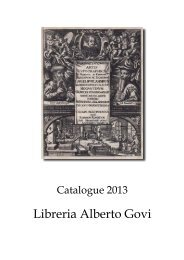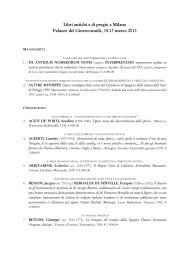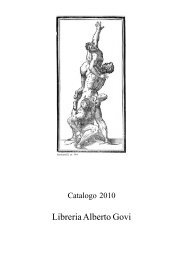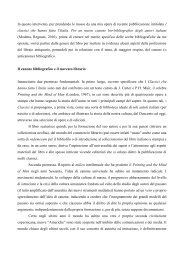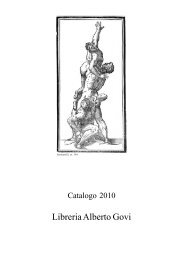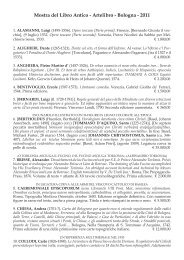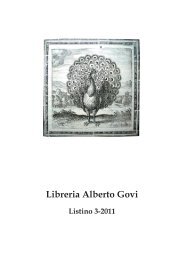List 4-2013 - Libreria Antiquaria Alberto Govi
List 4-2013 - Libreria Antiquaria Alberto Govi
List 4-2013 - Libreria Antiquaria Alberto Govi
You also want an ePaper? Increase the reach of your titles
YUMPU automatically turns print PDFs into web optimized ePapers that Google loves.
Sa n t a Ca t e r i n a d a Bo l o g n a<br />
1) ARIENTI, Giovanni Sabadino degli (ca. 1445-1510) - PALEOTTI, Dionisio (fl. 1489-1526). La vita della Beata Catherina<br />
da Bologna, Monacha de l’Ordine della Diva Clara, del Corpo di Christo. Bologna, Pellegrino Bonardo, [not before<br />
1550].<br />
8vo; early 20 th century vellum, gilt Prince of Essling’s coat-of-arms on panels, gilt edges (part of the label on spine is missing); (40) ll. On the<br />
title-page woodcut image depicting St. Catherine kneeling in front of St. Paul; on last leaf verso another woodcut showing the Crucifixion. A<br />
nice copy from the library of the celebrated collector and scholar Victor, Prince d’Essling (1838-1909), and from the library of Alex Jonsson<br />
(with his pastedown on the front end-leaf and with a purchase note dated 1948).<br />
RARE EDITION (one of two issues, see Catalogo unico, IT\ICCU\BVEE\005907) of this enlarged<br />
adaptation by Dionisio Paleotti, a Franciscan priest from Bologna, of the agiography of St.<br />
Catherine from Bologna written by Sabatino degli Arienti, whose text first appeared in print in 1490<br />
as a part of the work Gynevera de le clare donne. Paleotti changed the introductory part and added<br />
4 chapters ad the end related to the Saint’s miracles. He printed his version anonymously for the first<br />
time in Bologna in 1502 (cf. E. Graziosi, Scrivere in convento…, in: “Donna, disciplina, creanza<br />
cristiana dal XV al XVII secolo”, G. Zarri, ed., Roma, 1996, p. 304).<br />
At the end of the volume are laudatory verses and other texts by Pietro Azzoguidi, Tommaso<br />
Migliori, and Tommaso Beccadelli.<br />
Caterina Vigri (or Nigri), better known as Caterina da Bologna, was born in Bologna in 1413. She<br />
spent the first years in his native town, then moved to Ferrara, where she studied Latin and learned<br />
to illuminate books and to play viola. In Ferrara she also entered the ducal court and became maid of<br />
honour of Niccolò III’s daughter, Margherita. Around 1426, when Margherita got married, Caterina<br />
left the court and joined a group of devoted women, which had been founded in 1406. in 1431, after<br />
the dispersion of the group, Caterina together with some other sisters founded a monastery of Clarisse,<br />
where she remained for the next 25 years. Around 1456, as part of the creation of new monastic<br />
institutions, Caterina was invited to Bologna to found a new monastery, later called Corpus Domini,<br />
of which she became abbess. She spent the last years of his life, teaching and living in her monastery,<br />
until she died in March 1463. Caterina soon became an object of worship and his cult grew over time<br />
until the final canonization in 1712 (cf. Dizionario biografico degli Italiani, XII, 1979, S. Spanò; and<br />
- 2 -



